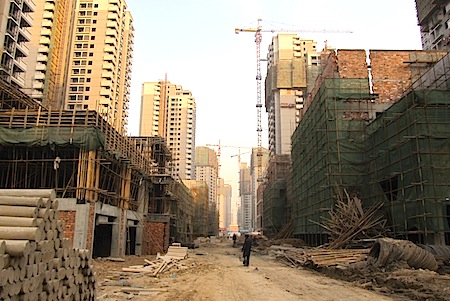
All those natural gas wells that are popping up by the thousands across the United States — they’re starting to appear in China, too. The global fossil energy boom, which in China has mostly meant soaring production of coal, is now beginning to include natural gas. And American and European multinationals are providing financing, equipment, and technical assistance.
The U.S. Energy Information Administration projects that China’s recoverable shale gas resources total 36 trillion cubic meters, or all but 9.5 percent of the shale gas reserves in Asia. China’s Ministry of Land Resources puts the reserves at 25 trillion cubic meters.
Given those resources, and the capacity to develop them, Chinese authorities are intent on doubling natural gas production over the next three years, boosting the fuel from 4 percent of China’s energy to 8 percent, according to the central government’s most recent five-year plan.
According to Ksenia Kushkina, a researcher at the Russian Academy of Sciences who made a presentation in Washington earlier this month, Shell and PetroChina completed the first horizontal well in Sichuan Province, in southwest China, in April 2011. The two companies drilled a dozen more since then, and plan 20 to 25 more wells in the field outside Chengdu. Exxon/Mobil and Sinopec completed a well in Hunan Province in January. Hess and Sinochem are working in Anhui Province. Dart Energy and CBM Henan have a joint agreement to explore for gas reserves in Henan Province.

Pete Marsters, a colleague and friend who’s studying in Chengdu, is closely following the development of shale gas resources in Sichuan. He sent this assessment yesterday: “What is going on now in shale is a test phase. China is setting up a lot of test wells in a lot of shale blocks (Sichuan, Anhui, Jiangsu, Zhejiang, among others) to, in my opinion, see which will be the easiest to bring to scale commercially.
“There are still a lot of questions to be answered before the large-scale feasibility of shale in China is determined. The first of which is economics. So far, wells here cost more than double those in the U.S. due to supply chain issues, newness of the industry in China, and the difficult nature of geology here (much deeper and more complex shales). Additionally, the ultimate productivity of Chinese shales is still up in the air.
“Then there are the water issues. At this stage and specifically in Sichuan, water doesn’t seem to be the main hurdle as resources are relatively plentiful. A large portion of China’s shale, though, is in extremely dry areas. This will be a future issue once the “easier” shales have been successfully tapped. There is a lot of money for foreign firms to come here, share technology, and help assess China’s shale potential. They are going gangbusters to do it (Chevron,Shell, Dart, Total, EOG, etc.).”
— Keith Schneider
its crazy to think of the damage that a population as large as china can bestow to the planet. But at least thay are more energy and green conscious than America well at least a little bit.
the only hope to helping save the planet is a mass economic downturn where people will realize all the production of useless crap is not needed and clean air water and food are far more important.